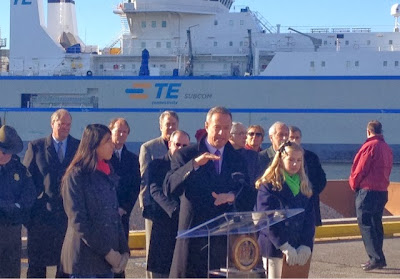Maryland's Governor Martin O’Malley was joined by more than 100 partners and stakeholders at the Port of Baltimore this morning for a first-hand look at approximately 2,750 tons of fossilized oyster shell en route to Harris Creek in the Chesapeake Bay.
Today’s barge load was the first shipment of material purchased from Gulf Coast Aggregates near Carrabelle, Florida that will be used to rebuild habitat in two Maryland oyster sanctuaries, made possible through an exciting new partnership with CSX. Over the next nine months, CSX will transport 112,500 tons of the fossilized shell by train – at cost – to complete planned reef restoration in Harris Creek and make major progress on similar efforts in the Little Choptank.
“Innovative programs and partnerships like these are making our record investments in restoration, aquaculture, stewardship and enforcement possible,” said Governor O’Malley. “Thanks to our friends at the National Fish and Wildlife Foundation, we today welcome CSX to Maryland’s oyster restoration family. Through their generous contribution we are moving our essential sanctuary work forward – work that is bringing our native oyster back to the Chesapeake Bay.”
With a lack of natural, affordable shell currently available to support restoration of the 377-acre Harris Creek sanctuary, the Maryland Department of Natural Resources and its partners found the quality and quantity of the next best thing – fossilized shell – from the quarry near Carrabelle. To address the challenge and expense of moving the large volume of material, the National Fish and Wildlife Foundation negotiated an agreement with CSX to transport the shell at cost.
“The restoration of the Chesapeake Bay oyster beds is critical for this region’s environment and economy – oystering is truly a way of life here in Maryland,” said Michael Ward, chairman, president and chief executive officer, CSX. “CSX is proud to be a part of this visionary public-private partnership to help restore one of our nation’s greatest natural assets, the Chesapeake Bay. Sharing expertise among these organizations, and tapping into each group’s unique strengths, is the only way this project could be done.”
Under the agreement, CSX will transport approximately 50 train cars of fossilized shell to Curtis Bay every 10 to 14 days between now and September, 2014; the shell will then be transported by barge to the Eastern Shore sanctuaries.
“The National Fish and Wildlife Foundation’s partnership with CSX has provided an amazing opportunity to help accelerate oyster restoration in the Chesapeake Bay,” said David O’Neill, the Foundation’s vice president for conservation. “Connecting CSX’s transportation services with the great work of the State of Maryland and its partners, including the Oyster Recovery Partnership, is another example of how public and private interests can work together to take a significant step toward a healthy Bay ecosystem.”
DNR purchased the materials at a cost of approximately $6.3 million; the CSX in-kind investment is approximately $2.4 million. The Maryland Environmental Service is coordinating the effort on behalf of the State. Production of young oysters and their placement on the new reefs will be conducted by the University of Maryland Center for Environmental Science and the Oyster Recovery Partnership (ORP).
“This collaboration is monumental as it allows us to complete the substrate construction of the largest tributary-focused oyster reef restoration project on the East Coast, possibly the nation,” said Stephan Abel, ORP executive director. “In all, more shell will be placed in Maryland waters over the next nine months than in the past decade ─ enough to cover 80 football fields with shell 12 inches deep.”
Harris Creek Sanctuary was chosen for the initial large-scale restoration project because its water quality, salinity levels, shape, location, and protected sanctuary status all point to a high likelihood of success. More than 150,000 cubic yardsof granite from a Maryland quarry will also be used as substrate in the sanctuaries. Scientists believe the project can ultimately serve as a blueprint to expand large scale oyster restoration efforts to other Bay tributaries.
“We are not only rebuilding our oyster population, we are also protecting these significant investments,” said DNR Secretary Joe Gill. “Our Natural Resources Police are monitoring oyster activity 24/7, by radar, in patrol boats and – in collaboration with the Maryland State Police – by air.”
Under Governor O’Malley’s leadership, Maryland has increased penalties for poachers, enhanced monitoring capabilities via the state-of-the-art Maryland Law Enforcement Information Network, and set aside certain days for natural resource court cases in more than 15 counties.
Maryland and its partners continue to make progress under all 10 points of the Governor’s Oyster Restoration and Aquaculture Development Plan, adopted in 2010. In October, Governor O’Malley announced another oyster restoration landmark, as the State and its partners produced and planted 1.25 billion oysters this year. The University of Maryland Horn Point Hatchery was responsible for the record – the first time any oyster hatchery in the country has passed the 1 billion mark for Eastern oyster spat production.
Federal, State and non-governmental partners working together to rebuild Maryland’s native oyster population include: The Environmental Protection Agency, National Oceanographic and Atmospheric Administration, US Army Corps of Engineers, University of Maryland Center for Environmental Science, Maryland Departments of Natural Resources, Environment and Transportation, Chesapeake Bay Foundation, CSX Corporation, Maryland Environmental Service, National Fish and Wildlife Foundation, and Oyster Recovery Partnership.


No comments:
Post a Comment